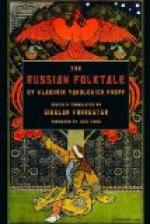the task of seeing how many ideas it contains
which are the familiar ideas of children, and
how they all have been “made different.”
All children love a tea-party, but what child
would not be caught by having a tea-party with
a Mad Hatter, a March Hare, and a sleepy Dormouse,
with nothing to eat and no tea! Red Riding
Hood was a dear little girl who set out to take a
basket to her grandmother. But in the wood,
after she had been gathering a nosegay and chasing
butterflies, “just as I might do,”
any child might say, she met a wolf! And what
child’s ears would not rise with curiosity?
“Now something’s going to happen!”
The Three Bears kept house. That was usual enough;
but everything was different, and the charm is in
giving the child a real surprise at every step.
The house was not like an ordinary house; it
was in the wood, and more like a play-house than
a real one. There was a room, but not much
in it; a table, but there was not on it what is on
your table—only three bowls.
What they contained was usual, but unusually
one bowl of porridge was big and hot, one was less
big and cold, and one was little and just right.
There were usual chairs, unusual in size and
very unusual when Goldilocks sat in them.
Upstairs the bedroom was usual, but the beds
were unusual when Goldilocks lay upon them. The
Bears themselves were usual, but their talk and
action was a delightful mixture of the surprising
and the comical. Perhaps this love of surprise
accounts for the perfect leap of interest with
which a child will follow the Cock in The Bremen
Town Musicians, as he saw from the top of the tree
on which he perched, a light, afar off through
the wood. Certainly the theme of a light
in the distance has a charm for children as it
must have had for man long ago.
Sense impression. Good things to eat, beautiful flowers, jewels, the beauties of sight, color, and sound, of odor and of taste, all gratify a child’s craving for sense impression. This, in its height, is the charm of the Arabian Nights. But in a lesser degree it appears in all fairy tales. Cinderella’s beautiful gowns at the ball and the fine supper stimulate the sense of color, beauty, and taste. The sugar-panes and gingerbread roof of the Witch’s House, in Hansel and Grethel, stir the child’s kindred taste for sweets and cookies. The Gingerbread Boy, with his chocolate jacket, his cinnamon buttons, currant eyes, rose-sugar mouth, orange-candy cap, and gingerbread shoes, makes the same strong sense appeal. There is a natural attraction for the child in the beautiful interior of Sleeping Beauty’s Castle, in the lovely perfume of roses in the Beast’s Rose-Garden, in the dance and song of the Elves, and in the dance of the Goat and her seven Kids about the well.
The beautiful. Closely related to this love of the material is the sense of the beautiful. “Beauty is pleasure regarded as the quality of a thing,” says Santayana.




